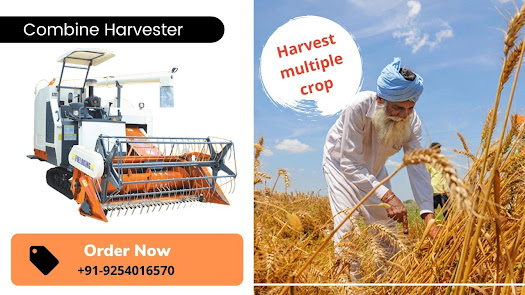How combine harvester helps farmers?
Combine Harvester
In modern agriculture, the combine harvester is a very useful agricultural tool for harvesting a variety of yields such as wheat, corn, soybeans, oats, rice, etc. The modern combine harvester, or simply combine, is a versatile machine designed to efficiently harvest a wide variety of grains from crops. In 1835, Hiram Moore built and patented the first combine harvester in the United States. According to government figures, 65 percent of the world's population still relies on agriculture. And if we talk about India, 75% of India's population is completely dependent on farming.
Scientists invented Combine Harvester machines so that they could make the life of the farmer easier and as the productivity at the farm needed improvement. This machine was named Combine Harvester because it automatically performs the crop work and separates the grain crops in one step, the work of harvesting such as reaping, threshing, gathering, and winnowing, etc. It can harvest crops such as maize, wheat, soybean, rye, barley, and oats. After collecting the crops, the Combine inserts them into a sieve drum that shakes the grains and separates them from the stalks, and carries the unwanted material to the back of the machine.
So, that is the working of the Combine harvester. The use of a Combine harvester is more beneficial to the grain farmers, Since combine harvester reduces the labour cost and as well as its empties the field for the next crop in the minimum time.
Advantages of using a combine harvester:
- Combine harvesters reduce grain losses compared to manual harvesting. Manual harvesting involves major crop losses in harvesting and carrying but all steps are easily accomplished without any grain loss using a Combine Harvester.
- A combine harvester machine is capable of harvesting and threshing an acre of land in an hour. Where a manual method would require at least 12 people to perform the same task, except for threshing.
- In the manual method, different steps are taken for threshing, which extends for several days and the crop remains in the field for a long time, which causes the risk of crop damage due to the rain of that time. Thus the time from harvesting to market preparation is a week or more in the manual method. But for Combine Harvesters, this process prepares the crop market in a few hours.
- Combine harvester provides grains of good quality compared to the manual process, for which the market is also willing to pay a better price. Considering the labor cost involved in manual harvesting, the cost of mechanized harvesting is much lower than the cost of manual harvesting.




Comments
Post a Comment